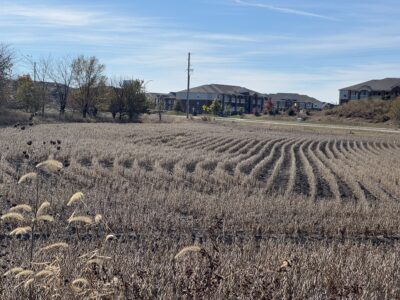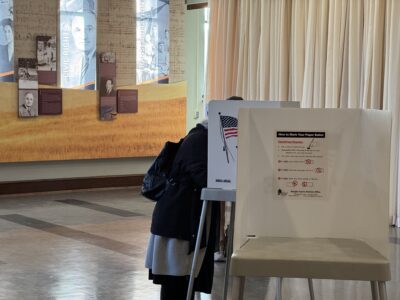
As federal job cuts loom, Douglas County already has a below-average number of fed positions

photo by: Mike Yoder
The Haskell Indian Nations University color guard participates in the annual Veterans Day Parade in downtown Lawrence on Saturday, Nov. 9, 2024.
If you are a federal employee, you have a lot on your mind currently — including, apparently, finding tips on how to write an email to America’s richest man.
On the chance you haven’t been following along, federal employees were given a deadline of midnight tonight to send an email to a government personnel account describing five tasks they accomplished last week. While the email technically is from the federal Office of Personnel Management, it has been labeled the brainchild of Elon Musk in his role with the Department of Government Efficiency.
Musk has said on social media that employees who don’t respond to the email would lose their jobs, although the Office of Personnel Management didn’t explicitly state that in its notice.
Nonetheless, the gambit has created a lot of questions. I’m sure there are a lot of really tough ones regarding the future going through the minds of many federal employees and their families. More broadly, there’s also questions about which communities might be hit the hardest if large amounts of federal jobs are eliminated.
That’s what I’m focusing on today. I’m using the latest numbers from the U.S. Bureau of Labor Statistics to show how many federal jobs are located in each county in Kansas, which has about 27,000 federal jobs statewide.
In Douglas County, there may be fewer federal jobs than you think. While government employment is a big part of our economy, the number of federal jobs here is actually below the Kansas average.
The BLS — using records required to be filed quarterly as part of the unemployment insurance program — reports there are 509 federal jobs based in Douglas County. That is almost exactly 1% of all jobs located in Douglas County. Statewide, 1.8% of all jobs are with the federal government, and nationally, 1.9% are federal jobs, according to the data from BLS.
If Douglas County had federal jobs at the average statewide rate, it would have about 950 federal jobs instead of the approximately 500 it does today.
If you are one of the federal workers currently in Douglas County, though, none of this is particularly soothing. The worry for individual federal workers doesn’t shrink just because Douglas County has fewer such workers.
It also is worth noting that the 509 number from BLS does not represent every Douglas County resident who is worrying about their federal job currently. For example, if you live in Lawrence but work for the IRS office in Kansas City, you are not included in the 509 Douglas County number from BLS. That number measures only federal employees who have a job in Douglas County. Douglas County residents who work at the Kansas City IRS office, for example, get counted with Kansas City’s numbers.
The Census Bureau does estimate how many residents in each county are employed by the federal government, regardless of where the job is at. The Census Bureau, through its American Community Survey program, estimates there are 1,248 Douglas County residents employed by the federal government, either in the county or elsewhere. However, the margin of error on the number is significant, plus or minus about 600 people, because the sample size is small.
The BLS numbers are much firmer, if not comprehensive. The BLS numbers don’t include enlisted members of the military, but they do include civilian employees of the military. We have some of those in Douglas County. Employees of the U.S. Army Corps of Engineers at Clinton Lake, for example, are civilian military employees. The BLS numbers also include employees of the U.S. Postal Service, even though it is not a true department of the U.S. government. Certainly, employees at Haskell Indian Nations University — where nearly 40 jobs already have been cut — are included in the figures. Other federal offices in Lawrence include the Social Security Administration, the U.S. Geological Survey, the U.S. Department of Agriculture, various positions that help veterans and other positions.
So, what community has the most at stake if federal job cuts become prevalent? It depends on how you measure it. Sedgwick County — home to lots of civilian jobs at an Air Force base plus a lot of regional offices for the federal government — has the most federal jobs in the state, at just more than 5,000. It also has the largest federal payroll, at more than $400 million per year.
But federal workers still make up a pretty small percentage of the total jobs in Sedgwick County. Just 1.9% of Sedgwick County’s workforce comes from federal jobs, which puts it very near the state average.
You could argue that Leavenworth County has the most at stake. It is home to a U.S. Army base and a federal prison, among other regional federal offices. It has the second most number of federal jobs at 4,241, as of June, which is the latest data available. Unlike Wichita, federal jobs make up a big percentage of all jobs in Leavenworth County. The numbers show 19.2% of all jobs in Leavenworth County are federal jobs. Not only that, they are good jobs. The weekly average wage for a federal job in Leavenworth County was $1,800, which equates to almost $94,000 a year.
However, there is one more contender for the community most at risk — Geary County, home to Fort Riley, which has experienced the ups and downs of federal jobs for decades. Geary County has 2,632 federal jobs, ranking it behind Sedgwick, Leavenworth, Johnson and Shawnee counties. But no county relies on federal jobs more heavily. The numbers show 21% of all jobs in Geary County are federal jobs. The average weekly wage was $1,424, or about $74,000 per year.
As I mentioned earlier, Douglas County’s 509 federal jobs make up 1.01% of all jobs here. That’s not a lot, but they are relatively good jobs, on average. The weekly average was was $1,515, or nearly $79,000 per year.
Here’s a look at all 105 counties in Kansas, first listing the number of federal jobs in the county and then listing the percentage total of federal jobs in the county. As a reminder, the statewide average is 1.88% of all jobs in the state are a federal job.
Geary, 2,632 jobs; 21.0%; Leavenworth, 4,241, 19.2%; Jewell, 27, 3.6%; Stafford, 37, 3.0%; Shawnee, 3,003, 3.0%; Lincoln, 27, 2.9%; Riley, 867, 2.8%; Ness, 27, 2.4%; Graham, 21, 2.3%; Chase, 20, 2.3%; Hodgeman, 14, 2.2%; Chautauqua, 17, 2.1%; Greenwood, 35, 2.1%; Wichita, 16, 2.0%; Osage, 64, 2.0%; Morton, 17, 2.0%; Rush, 22, 2.0%; Sedgwick, 5,034, 1.9%; Morris, 30, 1.8%
Smith, 26, 1.8%; Wallace, 11, 1.8%; Washington, 37, 1.7%; Linn, 38, 1.7%; Dickinson, 112, 1.7%; Woodson, 12, 1.7%; Phillips, 37, 1.7%; Osborne, 22, 1.7%; Coffey, 57, 1.6%; Edwards, 16, 1.6%; Sherman, 41, 1.6%; Rooks, 29, 1.6%; Cheyenne, 15, 1.6%; Trego, 18, 1.5%; Jefferson, 62, 1.5%; Greeley 10, 1.5%; Logan, 19, 1.5%; Marion, 53, 1.4%; Decatur, 13, 1.4%; Wyandotte, 1,346, 1.4%; Elk, 9, 1.4%; Sheridan, 15, 1.3%
Republic, 27, 1.3%; Barber, 22, 1.3%; Pawnee, 34, 1.3%; Rawlins, 14, 1.3%; Clay, 39, 1.3%; Bourbon, 69, 1.2%; Kingman, 35, 1.2%, Brown, 57, 1.2%; Lane 8, 1.2%; Wabaunsee, 17, 1.2%; Sumner, 75, 1.1%; Harper, 28, 1.1%; Ellsworth, 25, 1.1%; Anderson, 27, 1.0%; Jackson, 47, 1.0%; Meade, 17, 1.0%; Clark, 9, 1.0%; Wilson, 33, 1.0%; Russell, 26, 1.0%; Rice, 39, 1.0%; Douglas, 509, 1.0%; Ottawa, 13, 0.9%;
Marshall, 45, 0.9%; Scott, 21, 0.9%; Stevens, 21, 0.9%; Cloud, 32, 0.9%; Gove, 11, 0.9%; Mitchell, 30, 0.9%; Ford, 166, 0.9%; Atchison, 51, 0.9%; Ellis, 142, 0.9%; Labette, 77, 0.9%; Cherokee, 51, 0.8%; Neosho, 56, 0.8%; Stanton, 8, 0.8%; Johnson, 3,166, 0.8%; Doniphan, 22, 0.8%; Kearny, 13, 0.8%; Norton, 19, 0.8%; Saline, 240, 0.7%; Miami, 72, 0.7%; Kiowa, 9, 0.7%; Cowley, 101, 0.7%; Comanche, 5, 0.7%
Allen, 43, 0.7%; Haskell, 13, 0.7%; Nemaha, 41, 0.7%; Gray, 22, 0.6%; Montgomery, 100, 0.6%; Hamilton, 10, 0.6%; Grant, 16, 0.6%; Lyon, 97, 0.6%; Thomas, 26, 0.6%; Seward, 69, 0.6%; Butler, 121, 0.6%; Pratt, 29, 0.6%; Reno, 165, 0.6%; Franklin, 60, 0.5%; Pottawatomie, 57, 0.5%; Barton, 66, 0.5%; McPherson, 77, 0.4%; Crawford, 80, 0.4%; Harvey, 60, 0.4%; Finney, 86, 0.4%







